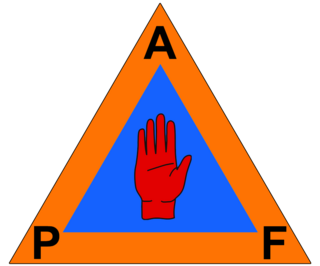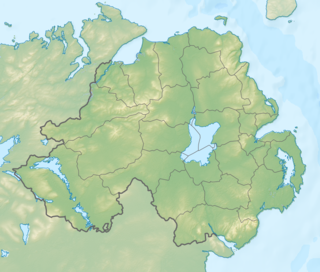
The East Tyrone Brigade of the Provisional Irish Republican Army (IRA), also known as the Tyrone/Monaghan Brigade was one of the most active republican paramilitary groups in Northern Ireland during "the Troubles". It is believed to have drawn its membership from across the eastern side of County Tyrone as well as north County Monaghan and south County Londonderry.
Cappagh is a small village and townland in the parish of Pomeroy in County Tyrone, Northern Ireland. It is between Pomeroy, Ballygawley, Galbally and Carrickmore, with the hamlet of Galbally about one mile to the east. Most of the land around Cappagh is farmland although a quarry lies just outside the village.
The Troubles in Cookstown recounts incidents during, and the effects of, The Troubles in Cookstown, County Tyrone, Northern Ireland.
The Troubles in Bessbrook recounts incidents during and the effects of the Troubles in Bessbrook, County Armagh, Northern Ireland.
The Troubles in Ballygawley recounts incidents during The Troubles in Ballygawley, County Tyrone, Northern Ireland.
The Troubles in Lurgan recounts incidents during the Troubles in Lurgan, County Armagh, Northern Ireland.

The name Protestant Action Force (PAF) was used by loyalists, especially members of the Ulster Volunteer Force (UVF), to claim responsibility for a number of paramilitary attacks during the Troubles. It was first used in this context in 1974, and has since been used to claim the killings of at least 41 Catholic civilians.

The Reavey and O'Dowd killings were two co-ordinated gun attacks on 4 January 1976 in County Armagh, Northern Ireland. Six Irish Catholic civilians died after members of the Ulster Volunteer Force (UVF), an Ulster loyalist paramilitary group, broke into their homes and shot them. Three members of the Reavey family were shot at their home in Whitecross and four members of the O'Dowd family were shot at their home in Ballydougan. Two of the Reaveys and three of the O'Dowds were killed outright, with the third Reavey victim dying of brain hemorrhage almost a month later.

On 28 February 1985, the Provisional Irish Republican Army (IRA) launched a heavy mortar attack on the Royal Ulster Constabulary (RUC) base at Corry Square in Newry, Northern Ireland. The attack killed nine RUC officers and injured almost 40 others; the highest death toll ever suffered by the RUC. Afterwards, a major building scheme was begun to give police and military bases better protection from such attacks.
This is a timeline of actions by the Ulster Volunteer Force (UVF), an Ulster loyalist paramilitary group since 1966. It includes actions carried out by the Red Hand Commando (RHC), a group integrated into the UVF shortly after their formation in 1972. It also includes attacks claimed by the Protestant Action Force (PAF), a covername used by the UVF. Most of these actions took place during the conflict known as "the Troubles" in Northern Ireland.

The Glenanne gang or Glenanne group was a secret informal alliance of Ulster loyalists who carried out shooting and bombing attacks against Catholics and Irish nationalists in the 1970s, during the Troubles. Most of its attacks took place in the "murder triangle" area of counties Armagh and Tyrone in Northern Ireland. It also launched some attacks elsewhere in Northern Ireland and in the Republic of Ireland. The gang included British soldiers from the Ulster Defence Regiment (UDR), police officers from the Royal Ulster Constabulary (RUC), and members of the Mid-Ulster Brigade of the Ulster Volunteer Force (UVF). Twenty-five British soldiers and police officers were named as purported members of the gang. Details about the group have come from many sources, including the affidavit of former member and RUC officer John Weir; statements by other former members; police, army and court documents; and ballistics evidence linking the same weapons to various attacks. Since 2003, the group's activities have also been investigated by the 2006 Cassel Report, and three reports commissioned by Irish Supreme Court Justice Henry Barron, known as the Barron Reports. A book focusing on the group's activities, Lethal Allies: British Collusion in Ireland, by Anne Cadwallader, was published in 2013. It drew on all the aforementioned sources, as well as Historical Enquiries Team investigations. The book was the basis for the 2019 documentary film Unquiet Graves, directed by Sean Murray.

The Tullyvallen massacre took place on 1 September 1975, when Irish republican gunmen attacked an Orange Order meeting hall at Tullyvallen, near Newtownhamilton in County Armagh, Northern Ireland. The Orange Order is an Ulster Protestant and unionist brotherhood. Five Orangemen were killed and seven wounded in the shooting. The "South Armagh Republican Action Force" claimed responsibility, saying it was retaliation for a string of attacks on Catholic civilians by Loyalists. It is believed members of the Provisional IRA carried out the attack, despite the organisation being on ceasefire.
The Hillcrest Bar bombing, also known as the "Saint Patrick's Day bombing", took place on 17 March 1976 in Dungannon, County Tyrone, Northern Ireland. The Ulster Volunteer Force (UVF), a loyalist paramilitary group, detonated a car bomb outside a pub crowded with people celebrating Saint Patrick's Day. Four Catholic civilians were killed by the blast—including two 13-year-old boys standing outside—and almost 50 people were injured, some severely.
The Step Inn pub bombing was a car bomb attack carried out by the Glenanne gang, an Ulster loyalist paramilitary group. The attack occurred outside the Step Inn Pub in Keady, County Armagh, when the pub was packed with people. The Ulster Volunteer Force claimed responsibility for the bomb attack.

The Ballygawley land mine attack was a bomb attack carried out by the Provisional Irish Republican Army (IRA) on the 13 July 1983. The IRA exploded a landmine under an Ulster Defense Regiment's (UDR) mobile patrol at Ballygawley Road, near Dungannon in County Tyrone, Northern Ireland. Four UDR soldiers were killed in the incident.

The Attack on RUC Birches barracks was an attack on 11 August 1986, the East Tyrone Brigade of the Provisional Irish Republican Army (IRA) attacked the Royal Ulster Constabulary (RUC) base at The Birches near Portadown, in North Armagh Northern Ireland. The unmanned base was first raked with gunfire before being completely destroyed by a 200 pounds (91 kg) bomb, which was driven through the gate of the base in the bucket of a JCB digger.

The Dungannon land mine attack was an Improvised explosive device attack and shooting against a British Army mobile patrol. The attack was carried out by IRA volunteers from the Provisional IRA's East Tyrone Brigade on 16 December 1979, along the Ballygawley Road, just outside Dungannon in County Tyrone. Four British soldiers who were on mobile patrol were killed in the ambush.
This is a timeline of actions by the Official Irish Republican Army, an Irish republican & Marxist-Leninist paramilitary group. Most of these actions took place as part of a Guerrilla campaign against the British Army & Royal Ulster Constabulary and internal Irish Republican feuds with the Provisional IRA & Irish National Liberation Army from the early 1970s - to the mid 1970s during the most violent phase of "the Troubles" in Northern Ireland.
A pub bombing or a public house bombing is an attack on a pub or public house using explosives and other bombing making material like nails, bolts & screws & similar objects which can cause horrific injuries when the bomb detonates. The Provisional IRA's Balcombe Street Gang used bolts & screws in many of their bomb attacks. Neo-nazi David Copeland used nails in his bombs which cause horrific injury.




